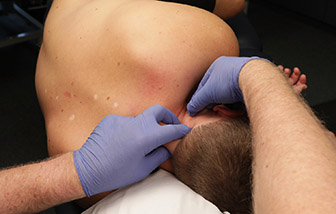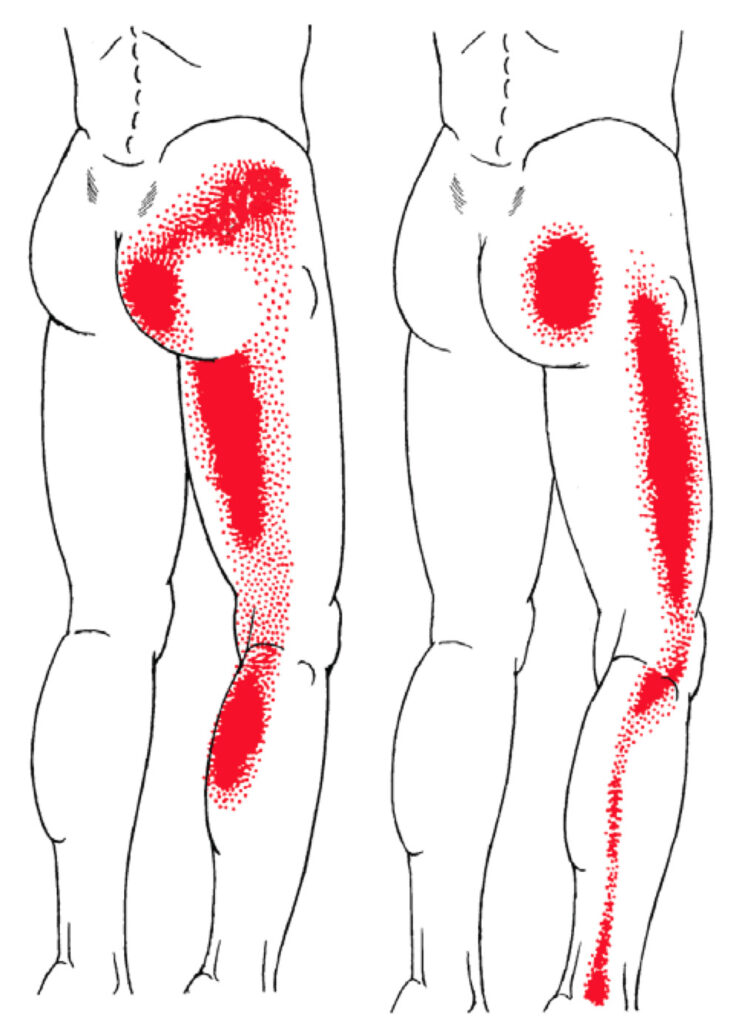I attended my first dry needling course through Myopain in 2017. I was impressed with what I saw in the class, including the quality of the education and the attention to detail by the instructors. Seeing positive results with my patients, I became fully certified in dry needling through Myopain Seminars.
As a chiropractor, I have always stressed restoring proper joint function through manipulation to get people moving better with less pain. Joint manipulation or “adjusting” can often be immensely helpful in this regard. However, as any astute clinician knows, every tool has its uses and limitations. By adding dry needling to my practice, I added an equally potent yet complimentary tool to my clinical armamentarium. Trigger point dry needling is to joint manipulation what peanut butter is to jelly.
I wish to describe two e xamples of how dry needling has aided me as a chiropractor (though there are many more than two!). We have all seen many patients with stubborn unilateral neck/upper back pain. Adjusting the cervical and thoracic spines may resolve these symptoms, or the pain may be persistent, and manipulation may only be palliative. By screening the ipsilateral shoulder, I have often found patients with stubborn unilateral neck/upper back pain to have altered scapular positioning, reduced glenohumeral internal rotation, and trigger points, most commonly in the infraspinatus, pec minor, upper and mid trapezius, levator scapula, etc. Dry needling of these trigger points (along with some clavicular mobilization if need be) can help normalize function and position of the shoulder, taking stress off the neck/upper back as the overworked trapezius muscle calms down. As a bonus, needling trigger points of the upper trapezius can also reduce headaches.
xamples of how dry needling has aided me as a chiropractor (though there are many more than two!). We have all seen many patients with stubborn unilateral neck/upper back pain. Adjusting the cervical and thoracic spines may resolve these symptoms, or the pain may be persistent, and manipulation may only be palliative. By screening the ipsilateral shoulder, I have often found patients with stubborn unilateral neck/upper back pain to have altered scapular positioning, reduced glenohumeral internal rotation, and trigger points, most commonly in the infraspinatus, pec minor, upper and mid trapezius, levator scapula, etc. Dry needling of these trigger points (along with some clavicular mobilization if need be) can help normalize function and position of the shoulder, taking stress off the neck/upper back as the overworked trapezius muscle calms down. As a bonus, needling trigger points of the upper trapezius can also reduce headaches.
Another area in which dry needling can be very helpful is with false or pseudo sciatica. A patient may talk like they are having sciatica, but when you test them, they don’t test positive for it. For these cases, I like to do length testing of the glutes and hip rotators side to side and then confirm further with palpation. Pseudo sciatica from trigger points in the gluteus minimus or hip rotators will manifest with reduced passive hip rotational range of motion and hypertonicity in these muscles. Dry needling trigger points in these muscles can resolve or really knock down these symptoms. Of course, I always assess for joint restriction and treat any joints of the lower extremity, spine, or pelvis that may be involved. Peanut butter and jelly.
test positive for it. For these cases, I like to do length testing of the glutes and hip rotators side to side and then confirm further with palpation. Pseudo sciatica from trigger points in the gluteus minimus or hip rotators will manifest with reduced passive hip rotational range of motion and hypertonicity in these muscles. Dry needling trigger points in these muscles can resolve or really knock down these symptoms. Of course, I always assess for joint restriction and treat any joints of the lower extremity, spine, or pelvis that may be involved. Peanut butter and jelly.
I prefer dry needling over other forms of muscle work for several reasons. First, dry needling generally works much faster. I have spent plenty of time grinding out muscle tightness with my hands and elbows. It’s like flying somewhere instead of driving. You get there faster, both in the time it takes during a treatment and in the amount of treatments to get a positive result. Second, dry needling saves your body, making it easier for you as a practitioner. Third, dry needling allows you to get into and directly work a trigger point that you could otherwise only apply indirect pressure to, especially deeper muscles, like the multifidus layer of the spine, psoas major, gluteus minimus, piriformis, etc. In my opinion, this is part of the reason it can be more effective than other forms of muscle work. As a side note, if your needling treatment does not yield the expected results, it’s time to put the needles away and put your thinking cap back on.
Trigger point dry needling is to joint manipulation what peanut butter is to jelly.
About this time, you may be wondering how you would bill for dry needling if you were to implement it in your practice. I’ll tell you what I do. There are two dry needling codes, 20560 and 20561, which correspond to the number of muscles you needle. This is much like our adjusting codes. These codes may or may not be covered by insurance. Obviously, if they are covered, I bill them, and they can be performed in the same region as CMT. If they are not covered, then I charge cash for the needling. Often, people are willing to pay cash because they like the results.
Dry needling has been immensely beneficial for my patients. It is not a panacea, but I have also seen many wonderful results. Over the years, I have been continually surprised by its effectiveness and am so glad to have it in my toolbox.
Rich Woolley, DC, MS, ATC, CMTPT/DN, CIDN
The Obvious Choice for Dry Needling Education
Dry Needling Course Series

The Dry Needling 1 course is an excellent starting point for learning the fundamentals of dry needling therapy. With a focus on the safe and effective application of dry needling techniques, you will gain a solid understanding of myofascial trigger points, needling techniques, precautions, and how to apply these techniques in clinical practice.

The Dry Needling 2 course is an intermediate-level course that provides in-depth knowledge and hands-on training for dry needling techniques of the extremities, including the upper and lower body. By completing this course, you will expand upon the skills you acquired in the DN-1 course and better understand the application of dry needling for managing musculoskeletal pain and dysfunction.

The Dry Needling 3 course is the final course in the series and the last step before becoming a Certified Myofascial Trigger Point Therapist – Dry Needling (CMTPT/DN). This course offers an in-depth study of advanced dry needling techniques for hand muscles, several lower extremity and foot muscles, the craniofacial and craniomandibular muscles, and more.

